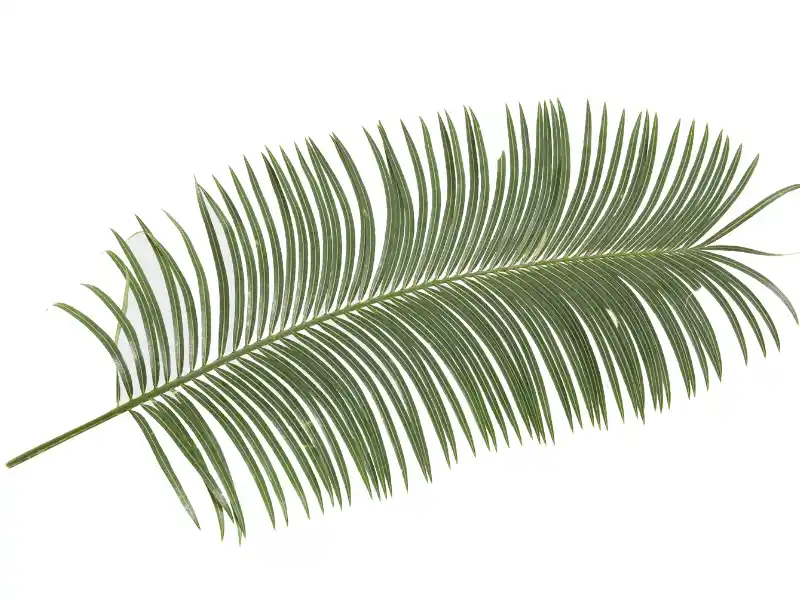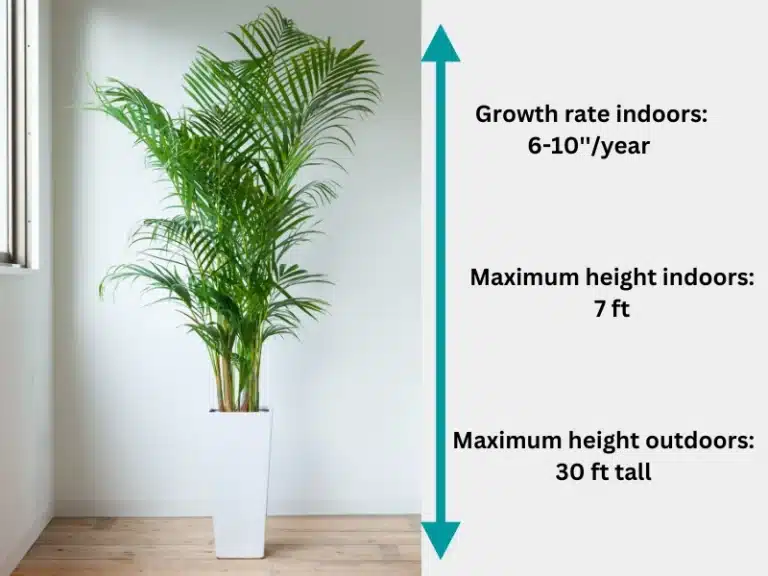What is a Palm Frond? Parts, Types, and Uses
Most species of palm trees can be distinguished by their large, compound leaves, also referred to as fronds. In some species, the fronds emerge folded up into a cabbage-like structure that’s edible just before it unfurls into a thick sheath, petiole, and leaflets. But what exactly is a palm frond? What are its parts and distinguishing characteristics?
What is a palm frond?
A palm frond is the foliage of a palm tree – usually growing from the top (crown) of the plant. There are 4 different types of palm fronds are distinguished by how they are arranged. They include entire, feather, fishtail, and fan fronds.

Some palm fronds are only a few feet long while others are several inches long. The color of a palm frond varies based on the species. Most species have waxy green fronds with a green, brownish, or gray tone on the underside.
In composition, palm fronds can be thin or thick or shiny or matte. In a nutshell, palm trees are identified based on the type or characteristics of their fronds.
Is a palm frond a leaf?
In common usage, a palm frond can be described as a large, divided leaf but it is not a leaf per se. Just like normal leaves, palm fronds usually have a stalk that connects various components of the fronds to the tree trunk (main stem).
Parts of a Palm Frond
Here are the different parts of a palm frond:

Palm leaflets
Leaflets are parts of the fronds that attach to the rachis. They are V-shaped in cross-section. The apex of the V has a midvein. Palm fronds with inverted V shape leaflets are known as reduplicates while those with upright V-shaped leaflets are referred to as induplicate.
Petiole (leaf stalk)
The leaf stalk connects the palm fronds to the main stem (tree trunk).
Rachis
The rachis is part of the petiole that bears leaves at short intervals. It extends from the end of the petiole up to the tip of the fronds.
Frond midrib (leaf sheath)
This is the base of the palm frond (end of the leaf stalk), where the fronds attach to the main stem.
Cabbage
This is the folded-up palm tree fronds. In some smaller palm species, the cabbage is an edible part.
Palm spines
These are prickles or thorns along the petiole. A chemical irritant may present on palm spines, so you must be careful when handling palm fronds.
Do Palm Trees Have Branches?
Palm trees don’t have branches. Instead, they produce a canopy of large leaves known as palm fronds. These leaves are supported or connected to the trunks by a flexible frond midrib.
When palm fronds are removed from most species of palm trees, they leave a circular or semi-circular mark around the tree. Some palm trees with crown shafts, such as bottle palm and royal palm, leave a ring around the trunk.
Types of Palm Tree Fronds
There are four types of palm fronds based on the different ways palm leaves grow or are arranged. These include:
Feather fronds (Pinnate leaves)
The leaves are feather-shaped, which means they are arranged symmetrically along both sides of the petiole (leaf stalk). They are similar to a feather and vary widely in size, from the size of your foot to a maximum of 75 feet
Fan fronds (Palmate leaves)
These are fun-shaped fronds made up of radiating leaves – leaves that originate from a single point on the petiole (leaf stalk), forming a circular or semi-circular appearance. The fronds vary in size from a few inches to 5 meters long.
An example of a palm tree with this type of fronds is the Washingtonia robusta (Mexican Fan Palm).
Entire fronds
These fronds comprise a single undivided leaf. One example of a palm tree with this type of fronds is the Chamaedorea geonomiformis (Necklace Palm).
Bipinnate fronds
The fronds resemble a fishtail. They are divided once into pinnae, but in some fronds, the pinna is further divided into segments. Individual fronds can be 3 meters wide and 4 meters long. These bipinnate fronds are found in the Fishtail Palm (Caryota spp.)
Common uses of palm fronds
1. Used as mulch
Old palm fonds, especially the ones that have stayed on the rooftops for years, can be chopped up and used as much. The entire fronds can be placed on top of raised shades to prevent direct sunlight from reaching the plants underneath. You can also strip individual leaves from the fronds and apply them directly on top of the soil.
2. Fencing gardens
Palm fronds can also be used to fence gardens. Some of the materials you will need include large palm fronds, live fence posts, and tying strips. If it’s a temporary structure, you can use thicker parts of the leaf stalk instead of buying fencing posts. The fronds will create a nearly impermeable garden fence that will keep most of the animals and birds away from your garden.
3. Palm leaves used as Windbreaks
A four feet high garden fence made of palm fronds can work as windbreakers for low-lying or young crops. The fonds can also be great weather shelters, especially for properties constructed on the seafront. You can make a thicker fence comprising palm fronds to thwart breezes away from your property or garden.
4. Woven crafts
Another common use of palm frond is to create woven crafts such as baskets, hats, and artisanal crafts. For instance, jipi japa palm fronds are commonly used to weave multi-color baskets. One of the advantages of palm frond woven crafts is that they are both malleable and durable.
5. Garden stakes
If you strip leaves from the fronds to use as much, you will be left with leaf stalks with spines that you can put to good use. One of such uses is the construction of garden stakes for climbing plants such as tomatoes, cucumbers, and beans.
One of the advantages of using palm fronds as garden stakes is that they can keep predators away. They also act as compost they are old and rotten.
6. Fuel for Fire
You can also use palm fronds especially leaf stalks as firewood. You can utilize them on cob ovens, rocket stoves, or any source of fire for your cooking needs. The smaller pieces of fronds can be used to feed the rocket fuel while the large pieces can be dried and saved for the cob ovens.
7. Paint stirrer
If you want something to stir or mix your paint before application, leaf stalks can be a good choice. Remove the leaves from the fronds and shape the stalks to create a mixing or stirring stick.
8. Palm thatch roofs
This is one of the common and the most favorite use of palm fronds. Palm thatch roofs are simple to make – they involve tying the palm fronds to roof frames. Such roofs work best for garden sheds, chicken coops, and compost bins.
9. Can be used as livestock feed
Many livestock keepers have made a business out of making livestock feeds from palm fronds. For instance, Arizona’s livestock producers target feed pellets manufactured from palm fronds as Palm Silage sets up a manufacturing plant in the state. They made the pellets by stripping leaflets from palm fronds and mixing them with dates.
10. Bonfire kindling
If you want to throw a party in your backyard and want to lit a bonfire, dried palm fronds can be a good fire starter. They burn quickly and light up extremely well. You only need to load your firepit with dried palm leaves and add some leaf stalks.
11. As a symbol
Lastly, palm fronds can also be used to celebrate Palm Sunday, Sukkot, or simply as a symbol of victory.
MORE ABOUT PALM TREES
- Palm Tree Roots – Identification and Uses
- Palmetto Tree vs. Palm Tree: Differences
- Palm Tree Diseases and Identification
- Types of Indoor Palm Trees
References
- T. K. Broschat, University of Florida: Palm Morphology And Anatomy
- University of Florida IFAS Gardening Solutions: Palm Leaf Structure
- Anderson, P.J, ID Tools: Identifying Commonly Cultivated Palms


